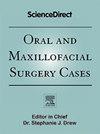Impressive regression of aggressive central giant cell granuloma with the use of intralesional corticosteroid injections
Q3 Dentistry
引用次数: 0
Abstract
Introduction
and importance: Giant cell granuloma (GCG) is a begnin tumor usually occurring in the mandible or maxilla. Clinical presentation can vary from small peripheral GCG to aggressive central GCG for which a surgical procedure can damage functional structures and have a poor aesthetic outcome. Alternative therapies are of essential interest in those cases, as a monomodal treatment modality or as a neoadjuvant therapy.
Case presentation
We herein present a case of aggressive central GCG in a 11 year old infant with a suspected pycnodysostosis treated with neoadjuvant intralesional injections of corticosteroids. Impressive reduction of the lesion was observed and the patient underwent surgical curretage of the remaining mass. The GCG recurred 7 months after surgery and the patient benefited from the same treatment plan. No sign of recurrence was observed after 29 months. The case has been reported in line with the SCARE criteria.(1)
Clinical discussion
GCGs commonly occur in a young population making the conditions management challenging in the maxillofacial region because of its anatomical relationship with vital and functional structures as well as the associated deformity risk. Different medical therapies have been described such as corticosteroid injections, biphosphonates, interferon alpha and calcitonin with a various degrees of success.
Conclusion
Surgery is the gold standard in treating GCGs, however alternative therapies should be discussed in the management of extensive lesions.
病灶内皮质类固醇注射后侵袭性中央巨细胞肉芽肿显著消退
巨细胞肉芽肿(GCG)是一种常见于下颌骨或上颌骨的初发性肿瘤。临床表现可以从小的外周性GCG到侵袭性的中央性GCG,其中手术可能会损害功能结构并导致不良的美学结果。在这些病例中,作为单模治疗方式或作为新辅助治疗,替代疗法是至关重要的。病例介绍:我们在此报告一例侵袭性中央GCG在11岁的婴儿与疑为结节性骨裂症治疗新辅助病灶内注射皮质类固醇。观察到病灶明显缩小,患者接受手术切除剩余肿块。术后7个月GCG复发,患者受益于相同的治疗方案。29个月后无复发迹象。(1)临床讨论:由于颌面区域与重要和功能结构的解剖关系以及相关的畸形风险,ongcgs通常发生在年轻人群中,使得颌面区域的病情管理具有挑战性。不同的医学疗法,如皮质类固醇注射、双膦酸盐、α干扰素和降钙素,都取得了不同程度的成功。结论手术是治疗gcg的金标准,但对于广泛病变的治疗应探讨替代疗法。
本文章由计算机程序翻译,如有差异,请以英文原文为准。
求助全文
约1分钟内获得全文
求助全文
来源期刊

Oral and Maxillofacial Surgery Cases
Medicine-Otorhinolaryngology
CiteScore
0.60
自引率
0.00%
发文量
43
审稿时长
69 days
期刊介绍:
Oral and Maxillofacial Surgery Cases is a surgical journal dedicated to publishing case reports and case series only which must be original, educational, rare conditions or findings, or clinically interesting to an international audience of surgeons and clinicians. Case series can be prospective or retrospective and examine the outcomes of management or mechanisms in more than one patient. Case reports may include new or modified methodology and treatment, uncommon findings, and mechanisms. All case reports and case series will be peer reviewed for acceptance for publication in the Journal.
 求助内容:
求助内容: 应助结果提醒方式:
应助结果提醒方式:


